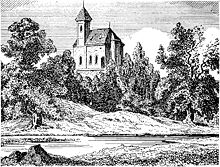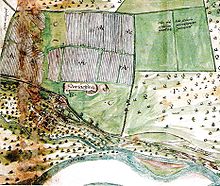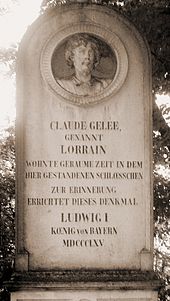Pilgrimage Church of St. Anna (Harlaching)
The Roman Catholic pilgrimage church of St. Anna in the Munich district of Harlaching is located on a Nagelfluhplatte close to the almost 30 meter steep slope of the eastern Isar - high bank above the Hellabrunn zoo . Today's church emerged from a church building ( lat. Ecclesia Hadelaichen ), which was probably first built in the middle of the 12th century , in the core of the former village, which is the origin of today's district of Harlaching. The first documented mention of the patronage of St. Anne , whose feast day is celebrated annually on July 26th, comes from the year 1524. Remnants of the original structure of the church are preserved in the choir tower .
The external appearance of the building, commonly referred to as St. Anna's Church or simply Annakircherl , has probably not changed significantly since it was first built and is still reminiscent of a late Romanesque village church, but inside a splendidly furnished room in the Rococo style awaits the visitor . In addition to many other art treasures housed in the building, the miraculous image on the high altar from around 1500 deserves a special mention, which is a wooden sculpture depicting Saint Anne herself . Today St. Anna is a popular wedding and baptismal church and a pilgrimage destination in September .
The construction and its equipment
Location and building description
From Harlachinger Strasse , a little above the bend, a short footpath along an unplastered stone wall leads to the archway of the cemetery , the grating of which was made by Karl Beck. In the middle of the small cemetery is the church building, which essentially consists of a compact choir tower facing east on a square base measuring about seven by seven meters, on which a single-nave nave on a floor plan of about eleven is located to the west on the slope edge times eight meters. The plaster and ocher yellow painted brick - masonry of the facade is white held Gliederungselemente as corner pilaster strip , roof cornices , window and door frames loosened. The almost windowless eastern front directs the visitor along the north wall of the building, loosened up by three high segment arched windows, to the low side entrance at the west end of the wall. The with red bricks covered gable roof binds via a side porch and the south attached to the choir vestry with overlying oratory and includes in a narrow strip and the medieval buildings in its choir tower. The tower, which is unusually low for a pilgrimage church, is covered by a pyramid roof, which is probably an emergency solution. A counterweight to the tower is the polygonal staircase built in front of the west facade , which leads to the organ gallery and the roof structure .
Vaulted ceiling and frescoes
The walls of the church are structured by simple pilasters , which carry a barrel vault up to 8.5 meters high with stitch caps in the nave and a flat dome in the choir .
The stucco work and the two ceilings frescoed in the nave and in the choir, which are limited to the vaulted area, are works from the workshop of Johann Baptist Zimmermann and probably come from his son and student Franz Michael Zimmermann . The sparingly used stucco ornaments, combined from plant and shell shapes, and the agraffes on the needle cap tips stand out in pale yellow from the gray-green background.
The high-format, single-view ceiling fresco of the nave shows the birth of the “Mother of God” Maria in a theatrum sacrum : Anna and Joachim receive their little daughter Maria (with a wreath of stars ) as a gift from God. A maid on the left in the picture under two angels looking down from a cloud brings bath water, while a second maid from behind on the right in the picture prepares the cradle for the child. The Latin inscription in the two stucco cartouches surrounding the fresco quotes from the Ave Maria : “PRO NOBIS ORA” - “IN MORTIS HORA” ( “ Pray for us” - “In the hour of our death” ).
In the dome fresco of the altar space in the choir enthroned the parents of Mary earthly existence caught up in the clouds. Mother Anna is depicted with book and sacrifice pigeons, Father Joachim with Shepherd shovel, they are flanked by cherub enpaaren in the gusset cartridges.
Altars and other works of art
Two inclined side altars in the chancel arch direct the gaze to the high altar , whose miraculous image dates from around 1500 and depicts St. Anne herself as a colored carving . The old picture was subsequently inserted harmoniously into a rococo frame. The picture frames of the side altars, as well as possibly the high altar and the pulpit with gilded angels on the pulpit, which is composed in a window, go back to a design by Ignaz Günther , which is now in the Germanic National Museum in Nuremberg, but they were made by an unknown Munich master simplified. Nevertheless, according to Norbert Lieb, they are "among the finest carvings of the Rococo".
The right side altar was commissioned by the St. Anna Alliance in 1757. The altarpiece shows Anna and Maria while reading the Bible, the magnificent rococo frame with the noble attributes (two lions, the Bavarian Kaiserwappen with chain and Georg military orders , insignia and imperial crown) was developed by I. Elector Karl Albrecht founded, under the name of Charles VII. from 1742 to 1745 was Emperor of the Holy Roman Empire and generously supported all three Annenkirchen in Munich out of gratitude for the birth of a Hereditary Prince . In the predella of the altar there is a rococo monstrance with relics of St. Boniface .
The left side altar, whose predella is adorned with an expressive Baroque pietà , is dedicated to Saint Joachim , the altarpiece is also surrounded by a rich, if artistically less elaborate frame. The letters J and A in the ray glorioles above the altar extracts again refer to the church patrons Joachim and Anna.
On the arches of the passageways on the left and right are statues of St. Joachim as a shepherd and St. Joseph with a blooming staff, as well as kneeling angels on rocailles . In the extension of the high altar , God the Father is enthroned, surrounded by nine choirs of angels .
From the heyday of the Anna pilgrimage in the 18th century, three votive images have survived , which suggest that at that time the small altarpiece on the right side altar Anna teaches her daughter Mary to read the Bible was viewed as a picture of grace, because they take everyone the motif of mother and daughter reading the Bible from the altarpiece as a picture quote. In connection with the pilgrimages, an annahand is also preserved in the church treasury , that is a wax copy of the right hand of the saint, which is said to be kept in Vienna. Two large votive candles that were placed at the beginning of the choir date from 1797 .
The pews, the confessional , the “Scourge Savior”, the figure “Christ in Rest” and the vestibule grille come from the redesign phase at the end of the 18th century, while the silver-plated eternal light can be dated to the era of classicism .
organ
The organ with two manuals and a pedal by Hubert Sandtner dates back to 1979. It has slide chests and mechanical game and stop action mechanisms .
She has the following disposition :
|
|
|
||||||||||||||||||||||||||||||||||||||||||||||||
- Coupling : II / I, I / P
history
Founding saga
According to an old, but not guaranteed, tradition of unclear origin, the church was donated by a wealthy nobleman as a token of repentance. The legend reports that the man fell in love with a beautiful girl from Munich's Jewish quarter and persuaded her to move to his country estate in Thalkirchen . After a few happy months, however, the patrician left the young woman for someone else, whereupon she drowned herself out of desperation in the nearby Isar . In order to atone for his guilt, the nobleman had the little church built. The soul of the suicidal woman is said to haunt the church at night as a delicate blue light and frighten late walkers.
Building and Church History
The building was first guaranteed in writing in 1186 as a church belonging to the Tegernsee Monastery . In a description of the Diocese of Freising from 1315, the church is then mentioned as a branch church of St. Georg in Unterbiberg .
The creation of the miraculous image of Anna herself can be dated to the beginning of the 16th century. In another Freisinger matrikel from 1524 which will then be the first time St. Anne as churches saint called writing. In 1527 the church was bought by the Wittelsbachers and thus came into ducal and later electoral possession.
In the Thirty Years War (1632) the church was looted and badly damaged by Swedish troops, then rebuilt in 1653. In 1678 the building received two new bells from the workshop of Johann Kippo , who in 1865 had already cast the "Elferin" for Old Peter in Munich.
In 1707 there is the first mention of St. Anne's thirties , an indulgence for which services were held annually on thirty consecutive days from September 15th. The St. Anna thirties supported by the brotherhood of St. Anne's Alliance, which was dissolved in 1853 due to a lack of members, founded the pilgrimage that is taking place in our day in honor of the church patroness.
In the 18th century, the church formed by shortly after 1700 by Baron Max Christoph von Mayr , designed by Enrico Zuccalli built castle Harlaching a common ensemble. Considerations for the rebuilding of the dilapidated church while retaining parts of the medieval choir are documented from 1751. In 1753 the ecclesiastical council approved a new church building using the Gothic tower. The new building was carried out by an unknown master builder between 1753 and 1761. The assumption made earlier that the court architect Johann Michael Fischer was in charge of the new building can be ruled out based on current knowledge. The church was spared during the looting by the French and the fire of the castle in 1796.
After secularization , St. Anna was initially subordinated to the parish Maria Hilf in der Au , from 1830 it was a subsidiary church of Heilig Kreuz in Giesing . Since 1913, regular services have been held in the church on Sundays and public holidays. In 1925, Neu-Harlaching became the Curate of St. Anna . With the establishment of the Holy Family parish in 1931, the Annakircherl was assigned to it. A renovation in 1933 removed traces of an unsuccessful renovation from 1899, during which the church was also equipped with five glass windows from the Bockhorni company, Munich. In 1937 the church received a wooden statue of Mater Dolorosa as a foundation , which is located in the sacristy.
During the Second World War , the roof of the church was hit by incendiary bombs in an air raid on the night of September 6-7, 1943 . The nearby economic buildings burned out and threatened the church additionally. The chaplain at the time was able to extinguish the burning roof with the help of some men from the neighborhood.
In 1948 a monstrance was stolen from the church. In 1959, the interior was thoroughly restored by Karl Eixenberger under the direction of the Bavarian State Office for Monument Preservation . The damp masonry was drained and the original color scheme of the interior was reconstructed. The windows were re-glazed with round leaded panes by the Grün company from Taufkirchen . The following year, the church was painted pink and white during an exterior renovation, and the tower was given a new pommel with a cross.
In 1968 the church received a wooden statue of the Patrona Bavariae as a foundation . In the "Olympic year" 1972 and 1973, the roof structure was renewed , which was then covered with "church beaks ",
and the church was given its current paint scheme in ocher and white, based on the original color scheme after scratch tests. In 1976 the eastern cemetery wall was rebuilt. In 1982 the church burned, most likely after the sacristy was set on fire. A complete interior renovation was required and was carried out in a row. In 1989 the western cemetery wall was renewed and anchored in the Nagelfluhplatte with steel nails. In the 1990s, the property east of the cemetery was built on, which means that a free view of the church from the east and south (Lindenstrasse), as documented, for example, on the church guide from 1973, is no longer possible.
Complementary
Claude Lorrain Monument
In 1865 King Ludwig I donated a monument to the French painter Claude Lorrain .
St. Anna in the logo of a shooting society
The "Schützengesellschaft Harlaching-Waldperlach eV", founded in 1928, has the St. Anna church in the club logo, a picture of the church is shown on the club flag and a target .
Individual evidence
- ^ Lothar Altmann: Pilgrimage Church of St. Anna . Munich 1989, p. 3.
- ^ "Matriculation of the Freising Vicar General Stephan Sunderndorfer", 1524. In: M. von Deutinger: The older registers of the Diocese of Freising I-III . Munich 1849/50
- ^ Norbert Lieb: Munich. The story of his art. Munich 1982, p. 220
- ^ Organ Databank , accessed on September 4, 2019.
- ^ Lothar Altmann: Pilgrimage Church of St. Anna . Munich 1989, p. 11
- ^ Th. Wild: Chronicle of the branch and pilgrimage church of St. Anna Munich Harlaching . Manuscript, Munich 1977, p. 32. Quoted from Dorle Gribl
- ↑ Schützengesellschaft Harlaching-Waldperlach eV ( Memento of the original from February 12, 2008 in the Internet Archive ) Info: The archive link was automatically inserted and not yet checked. Please check the original and archive link according to the instructions and then remove this notice. Homepage
- ↑ Schützengesellschaft Harlaching-Waldperlach eV ( Memento of the original from September 27, 2007 in the Internet Archive ) Info: The archive link was inserted automatically and has not yet been checked. Please check the original and archive link according to the instructions and then remove this notice. photography
literature
- Heinrich Englmann: St. Anna Pilgrimage Church Munich - Harlaching , Schnell Art Guide No. 51. Schnell & Steiner, Munich and Zurich 1973 (third, revised edition)
- Lothar Altmann: Pilgrimage Church of St. Anna Munich - Harlaching , Schnell Art Guide No. 51. Schnell & Steiner, Regensburg 2004 (6th edition), ISBN 978-3-7954-4108-1 .
- Dorle Gribl: Harlaching and the Menterschwaige - From Noble Seat to Garden City . Buchendorfer, Munich 2004, ISBN 3-937090-05-3 .
- Georg Dehio : Handbook of German Art Monuments, Volume Munich , Munich / Berlin 1996
Web links
Coordinates: 48 ° 5 ′ 43 ″ N , 11 ° 33 ′ 23 ″ E



















